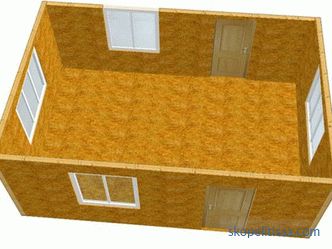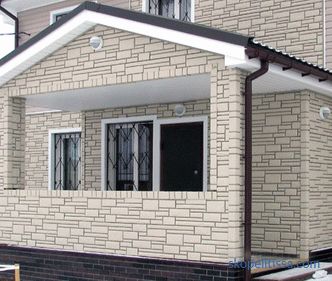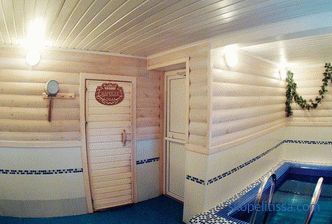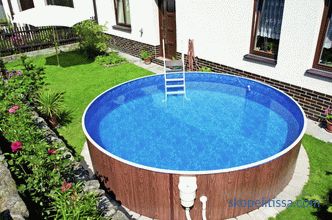The article will talk about how to create a Japanese-style garden on your own backyard plot, what thematic concept is best used for this, what principles to rely on when implementing the chosen stylistic direction. A photo selection will illustrate the main points, the video will reveal the secrets of creating individual elements of oriental landscape design.
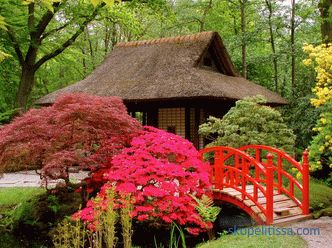
A bit of history
The goal of any landscape design direction is as skillfully and naturally as possible at the same time to combine human influence and the riot of natural elements. Most fully similar harmony reflects the garden, decorated in the traditions of the Land of the Rising Sun. The principles of its creation were perfected for centuries, therefore, today there is a whole doctrine, which is based on modern designers and create magnificent man-made parks.
For the first time the word "garden" in Japanese manuscripts appeared in the eighth century of our era. Initially, it was used to designate a separate space that did not have any artificial fences. Inside it began to appear objects that allowed a person to move around the area and admire the beauty of nature. These were stone paths, small architectural forms composed of them - resting places.
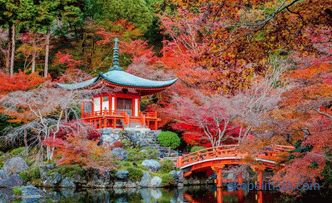
To them were presented servants who followed the cleanliness. Gradually, they began to improve the objects entrusted to them. During the reign of Heian, science and painting flourished. It was so popular that even gardeners tried to draw pictures with plants. They created such amazing masterpieces that they were admired by everyone without exception. This concept of landscape design of the Japanese garden dominated during the heyday of the Yamato-e school. When samurai came to the board, pomp and excessive decorativeness gave way to monochrome and conciseness. The era of "dry" landscape has arrived. Her idea defined the basic principles of the modern trend.
The rules for creating the style
Japanese park complexes are based on three basic postulates:
-
Indispensable combination of stone and water - male symbols and feminine.
-
Asymmetry of main zoning with an emphasis on one part of the design.
-
Use of plants native to the area and traditional decoration.
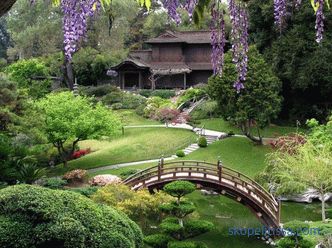
If you want to create a Japanese-style country garden, you must use additional structures: open areas, restrained, but very harmoniously combined with each other colors and their shades.
Different types of concepts
Today there are four topics that can be taken as a basis for the design of the infield:
-
Tsubo .
-
Rock Garden .
-
Garden of trees .
-
Tea Garden .
Tsubo
Tsubo is a direction that was formed as part of the urban structure of the early Middle Ages. Translated from the Japanese word "tsubo" denotes a plot of small size, the area of which is 3.3 square meters. Such a garden was broken up in tiny yards under the open sky and even inside individual rooms. When it was created, the gardener was given one task - to let light and nature into a small corner of the city.
To achieve this goal, plants were chosen that could feel well in constrained Spartan conditions. Since such a garden grows poorly grass and flowers that love the sun, their absence was compensated by fluffy moss. The entire perimeter of the land was covered with stone boulders, for plantings a small patch was left in the center of the stone composition. On it were planted shrubs that match the style of the building. The lack of light is compensated by artificial lighting, stylized lamps and a gallery of mirrors. They will be the final touch that will visually increase the amount of space. To create such a Japanese-style garden at the cottage is easier than ever: you need to make paths of stones, hang a large lantern of tsukubai and harmoniously distribute greenery between them.
Rock Garden
This is a pure product of Japanese philosophy. He is an interpretation of an ancient motive that symbolizes the eternal search for immortality. Although today there are few who preach such teachings, the concept itself is very popular among lovers of strict minimalism.
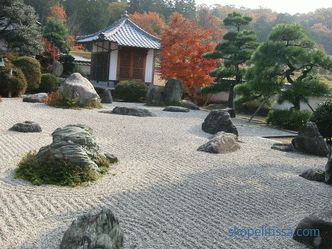
On our website you can familiarize yourself with the most popular sites in Moscow Region for building a country house . In filters you can set the desired direction, the presence of gas, water, electricity and other communications.
The Japanese themselves never used stones as a building material. For them, they were mediators between man and god. They were worshiped, the inhabitants of the Land of the Rising Sun are still talking to them, they pass on their experiences and ask for help. Therefore, in the landscape design of the Japanese style stones are objects of worship and admiration.
The echoes of the cult relationship are felt in the method of placing boulders. It is only at first glance it seems that the stones are arranged chaotically, in fact there is a strict principle, which must be followed when creating a replica.
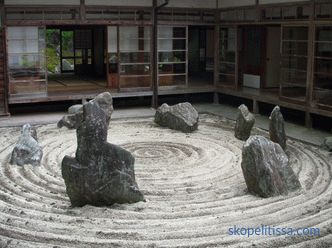
The largest boulder should be placed in the center of the site. He is a symbol of the distant summit of Mount Horui. At a small elevation or near the reservoir you need to form a composition consisting of three boulders. They symbolize the mountain of Syumi. Crane islands and tortoises - with the help of stones, figures are laid out in a shape resembling these representatives of the fauna. The selection of suitable stones is paramount. Since each boulder should help shape the tortoise shell or the wings of a crane, you have to spend time searching for the right material. Therefore, experts recommend not to buy it in large quantities in one source. It is better to look for them on the ruins or near river reservoirs.
Technique of creation
To achieve these goals, we need not only stones of the desired shape, but also other necessary material: gravel, large river pebbles, geotextiles. Experts recommend to purchase in advance for planting stunted plants (thyme, kemelomka, heather), as well as evergreen shrubs (boxwood, pieris, camellia). If such plants are not present in the region represented, they can be replaced by evergreen rhododendrons or calendula. For work you will need a shovel, rake, crowbar and knife.
First you need to find a suitable place for a rock garden. It should be well viewed from the entrance point of the house. The selected site is pre-leveled, the top layer of earth is removed from it to the depth of gravel backfill. Geotextiles are lined to the bottom of the prepared pit. It will not allow weeds to sprout through a stone pillow.
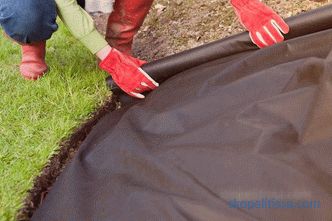
This can be interesting! In the article on the following link, read about how to arrange a lawn in the country: varieties of landscape solutions, care +45 photos .
A layer of gravel is poured on the geotextiles. He leveled rake. To create a special aesthetic effect, it is better to purchase friable crumbly material. In the center of the site we put the highest boulder. To his left, a stone-like composition resembling a crane is formed, to the right a turtle is going. The linking element should be the plants planted in the background of the garden.
For a tortoise shell it is worth choosing and laying one large flat stone. It should be almost square. For better effect, place it on a small hill. It can be formed by increasing the layer of gravel. Then you need to set the head. It is suitable for an oblong stone with a slight slope. In form, it should resemble an attractive reptile, slightly raised up. Stones with side sloping surfaces are suitable for feet. Installing them, you need to move the stones slightly away from the shell. A smaller boulder is selected for the tail.
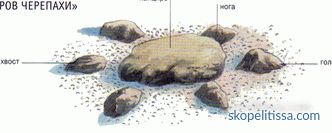
The "Crane" Islands are formed a little differently. You need to start with the establishment of the wings. Large triangular stones should be used as them. They are placed on the same horizontal line at a distance of thirty centimeters from each other. Between the wings fit stone neck - a long low flat boulder. Between the wings, just below their possible point of contact there will be a stone-body. It should be one third taller than the wings. Adjacent to it is a small stone-tail. In the end fit the stone-head. It should be small in size and triangular in shape. If the head and tail are slightly moved away from the main composition, the “Crane” islands will acquire the correct shape.
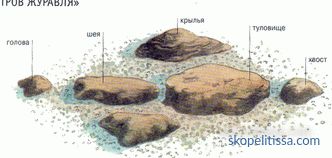
There is no need to show a desire to achieve perfection of the composition, and its realism. The Japanese-style garden is a product of symbolism. Contemplation of the overall picture should cause a flight of fantasy and make a person think.
The Island of Crane does not need to be planted with plants, the stones must be left all alone. But the island of "Turtles" can be decorated additionally. To do this, experts use stunted drought-resistant plants. In the end, you should get something similar to what is shown in the photo.
A rock garden will look even more impressive against a green lawn.Or shrubs in height and a half meters. According to the legends of the Japanese, such a combination brings harmony and peace to the house. Of course, you can move away from traditional canons and create miniature compositions, according to your fantasy pallet. But at the same time you should not place the blocks strictly along the ascending or descending lines: the Japanese do not tolerate artificial symmetry. Mountain and sea stones are never combined in one composition. This is another fundamental principle.
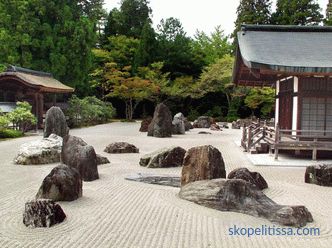
It may be interesting! In the article on the following link read about 115> winter garden in the house: features and varieties, feasibility and construction .
If huge boulders are used, the technique of creating a garden changes a little. First, the stones are installed and buried in the ground, then geo-textile is lined between them, and only after that a gravel bed is created. To hide defects and chips used plants. Best of all, Japanese grass is suitable for these purposes in landscape design. It is used very carefully and fragmentary. It has soft long leaves, their linear shape resembles bamboo stalks. Growing up, it becomes like a fluffy ball.
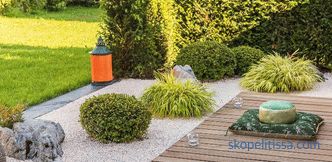
Its height does not exceed 50 cm. The grass grows slowly and periodically throws processes that root themselves. Hakonehloah bushes grow in one direction. The result is a green cascade. It looks good in other types of Japanese gardens. Planting such a plant in the stone, you need to ensure that the grass does not grow.
The video shows how Japanese grass grows in a garden:
Garden of trees
Such an object is more common for Europeans to understand . It is created around the open area along which the stream flows. On the banks of the land planted mass of green plants. Evergreen and deciduous trees take root in shady corners. They are successfully complemented by evenly cut shrubs of boxwood or cotoneaster. They perfectly mask garbage containers, fences, and unsightly walls of outbuildings.
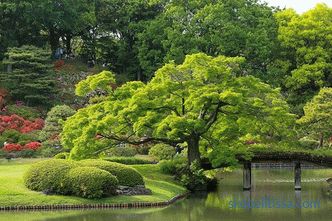
In the video, you can see a Japanese garden in the summer cottage:
It may be interesting! In the article, the following link read about country style for a country plot or how to create a cozy village estate .
Great attention in the garden of trees is paid to decorative elements. There are a lot of them. They are fences, gates, bridges, lanterns. If the fence is used inside the park, it is made light, airy, predominantly of bamboo or picket fence is created. External fences are made monumental and erected from stones. Additionally decorated with tiles.
Experts recommend taking the Yang-Yin theory as the basis for the general construction of such a garden. It allows you to create harmonious compositions. An artificially created reservoir may appear in their center.
How to make a pond on a hilly terrain will show the following video:
Starting from it, it is easy to alternate planes and vegetable masses, to combine smooth lines of the coast sheer cliffs of hills, mountains, close to large plants to plant small ones, create a balance of contrasts in everything. Then everything will turn out quite naturally.
Tea Garden
When creating it, designers pursue one goal: they create an atmosphere of complete peace in which you can admire nature and enjoy its tranquility. On a small area formed a corner of mountainous terrain. It was there that sages and philosophers usually settled in Japan. In the depths of such a garden should be a gazebo for the tea ceremony. It is called in the Land of the Rising Sun "Tyasitsu". Its appearance should resemble the housing of the sages. Those preferred to exist in an atmosphere of strictly asceticism. It is believed that it is she who is able to open a person to tune in to the contemplation of the beauties of nature.
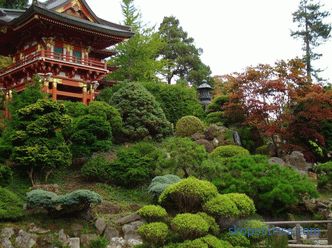
It might be interesting! In the article the following link read about garden sculptures: 10 original ideas on how to decorate your garden + examples in the photo.
The tea garden is designed in a very discreet style. Everything should be reminiscent of untouched mountainous landscapes. To illuminate the area are used lights, emitting a muffled light. Until recently, they were used precisely to recreate the described concept, but today Japanese lights are the calling card of the entire style as a whole. Therefore, today you can see how these decorative elements adorn the laconic stone gardens.
As a rule, only one light source is installed. But he invariably settles on a large stone pedestal - tatigata. The luminous flux is directed downwards.Another indispensable attribute of the tea garden is the bridge. If there is a stream or a river at the site, it must necessarily connect two banks. If there is no water, the bridge is able to connect the two slopes of the cleft or simply mark an imaginary obstacle that it can help overcome.
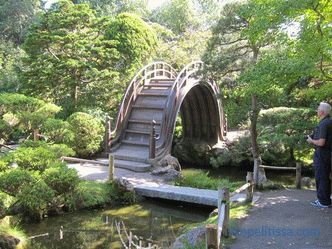
Sometimes such an object is not designed for walking at all, it acts as an expensive decoration. The Yatsuhashi bridge, made of stones or wide boards, looks extremely decorative. The details of such structures are often stacked in a zigzag, so it is impossible to pass through them. But they organically fit into the overall style of the garden, and are greatly appreciated for their high decorative effect.
How to create a corner of miniature Japan on your own plot, show the following video:
Flowers for a Japanese Garden
Described Objects It is difficult to imagine without flowering rhododendra. But to get involved in such bright accents is not necessary. The flowerbed in the Japanese style is very different from the traditional European flower garden. As a separate element, it simply does not exist. But often modern designers use a decorative technique and create flower arrangements that carry the image of a marsh, heath, mountain slope or dry stream. At the same time, a group of plants of one species and one variety is randomly planted, which, after growing, will form one colorful carpet.
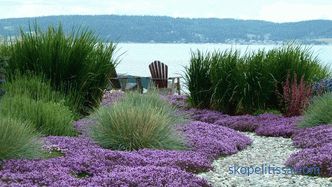
It might be interesting! In the article on the following link read about the highlight of the landscape is a “floating” staircase and garden paths under which the grass can grow.
Generalization on the topic
A properly laid out garden in the Japanese style can tell a lot to the residents of the Land of the Rising Sun about its owner. For Europeans, such objects are only magnificent corners, capable of demonstrating a skillful combination of light, greenery, water and stone. Studying the principles of building such a landscape design, many open the door to the world of knowledge of Eastern culture and philosophy.
